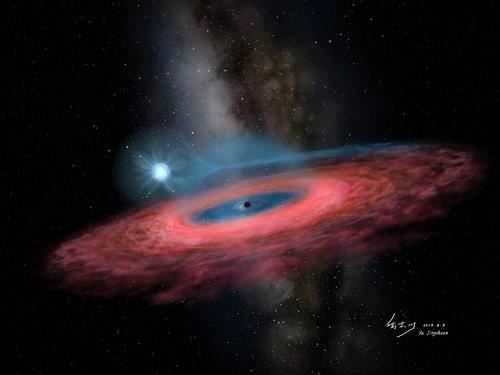
(Newser) – A stellar black hole, 70 times the mass of our sun? No way, experts said—and yet, there it is. A group of Chinese-led scientists have spotted this "monster" black hole some 15,000 light-years away and dubbed it LB-1, the Washington Post reports. "Black holes of such mass should not even exist in our galaxy, according to most of the current models of stellar evolution," lead scientist Liu Jifeng says in a press release. "...Now theorists will have to take up the challenge of explaining its formation." To grasp that challenge, look at how such black holes are formed. NASA says it happens when big stars expire in a supernova blast that collapses under the force of gravity. The gravitational pull gets so strong that nothing can escape, even light.
But LB-1 seems too massive to be created by a single star—after all, our galaxy's other stellar black holes have just five to 20 times the sun's mass. (That's unlike supermassive black holes, usually at the heart of galaxies, which are way, way, heavier.) Maybe LB-1 was created by two black holes that later captured a star? Or by a "fallback supernova"—a thus-far theoretical notion—in which a dying star ejects only some matter, which falls back in, making a heavier black hole? Both seem possible. Another exciting element is that LB-1 was detected with telescopes, a fairly new way of spotting black holes. All told, a scientist says, the find helps point "towards a renaissance in our understanding of black hole astrophysics." (Meanwhile, there might be an invisible "fifth force" in nature.)
https://news.google.com/__i/rss/rd/articles/CBMiRWh0dHBzOi8vd3d3Lm5ld3Nlci5jb20vc3RvcnkvMjgzNjY3L2ltcG9zc2libGUtYmxhY2staG9sZS1leGlzdHMuaHRtbNIBAA?oc=5
2019-11-30 22:15:00Z
CBMiRWh0dHBzOi8vd3d3Lm5ld3Nlci5jb20vc3RvcnkvMjgzNjY3L2ltcG9zc2libGUtYmxhY2staG9sZS1leGlzdHMuaHRtbNIBAA
Tidak ada komentar:
Posting Komentar